Natylie Baldwin's Blog, page 16
July 1, 2025
Matt Stoller: The Best and the Brightest Under Pressure
By Matt Stoller, Substack, 6/8/25
…I’m going to focus on something personal, which is my role as an American elite, because it intersects with a political fight that’s going on right now. This weekend was my 25th reunion at Harvard. And Harvard is in an existential fight with the Trump administration. The White House is seeking to cut funding for scientists and researchers affiliated with Harvard, and to block the ability to host international students. This attack was a live topic of conversation among alumni. And it felt, well, weird.
One of my favorite movies as a kid was Glory, the story of the first all-black regiment to fight in the Civil War, the 54th Massachusetts Volunteer Infantry Regiment. The 54th had white officers, and its first commander was Harvard graduate Robert Gould Shaw, who was killed in battle along with a lot of his troops, many of whom were ex-slaves.
Shaw’s name is displayed prominently in an important building at Harvard, Memorial Hall, which houses both Annenberg, where freshmen eat meals, and Sanders Theater, a large lecture hall for beginning economics, the most popular class among undergraduates. I would sometimes just stare at the hallway where his name was listed, along with other Harvard alumni who died fighting for the Grand Army of the Republic, which sought to end slavery and preserve the union. This martial tradition at Harvard stretched back and forward hundreds of years; a third to a half of Harvard graduates in the 1640s went to England to fight for Oliver Cromwell in the English Civil War, and tens of thousands of Harvard graduates served in World War II.
But during the war in Vietnam, that tradition ended. I didn’t know people like Shaw. Serving your country, potentially sacrificing your life, that’s rare for Harvard graduates, except for unusually service-oriented types, or for those with political ambitions. I don’t want to be overly romantic about the past, but something is different today about Harvard. The last 25 years, since I graduated, are almost perfectly correlated with a period of disconnect between elites, and everyone else.
That’s not to say what the administration is doing is good. It’s not. But it is to say that there is a reason our institutions are under attack, and yet have limited popular legitimacy. Harvard is fighting back against Trump with litigation. There is a quiet pride among alumni now, a feeling that Harvard is going to be pretty badly wounded, but also, a sense that there’s some integrity there, somehow. And yet, while elites are waking up a bit, there is much further to go.
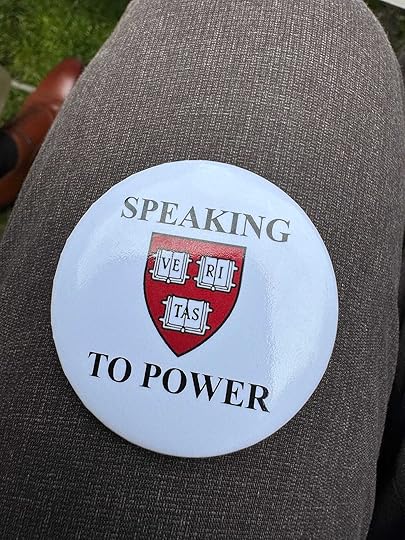
It’s not an inspiring moment. The university’s former President, Claudine Gay, a mediocrity, resigned last year over a fake scandal around anti-semitism and then allegations of plagiarism, and a milquetoast Jewish economist, Alan Garber, has taken over. In his speech to alumni, he talked about hearing from people unaffiliated with Harvard from all over the country, in all walks of life, from truck drivers to social workers. Someone like Garber spends most of his time dealing with annoying egomaniacs like Larry Summers, as well as billionaires. To hear from normal people, well, he seemed genuinely affected by that, and the fact that ordinary people care about the institution, and back him when the billionaires got scared. He also talked about the need for reform, recognizing that the anger at Harvard isn’t totally undeserved.
The practice of law, especially in areas like antitrust, lives at the intersection of elite practitioners representing the broad public. I am well-versed in why elites are distrusted, because I know where I went wrong. My failure was in 2002, when the debate over the war in Iraq was white hot. As a good Harvard graduate, I spent a lot of time reading and studying before forming an opinion. I went to panels with Iraqi dissidents, I read the Brookings Institute’s The Threatening Storm: The Case for War in Iraq – research assisted by a Harvard grad in my class. I paged through the New York Times and especially Tom Friedman’s columns, and I believed what good Democrats like John Kerry and Hillary Clinton told me. I went to protests and talked to anti-war protesters, and did my own surveys of their views. And I came away from it all feeling smug, that the war was a good idea, but more importantly, that the people who thought the war was foolish and immoral, well, they were unsophisticated.
Just before the war started, I realized my error, but I still kept the attitude. Yes I was wrong, but for the right reasons. I listened to the appropriate people, used the right salad fork. But then something happened that didn’t make sense. There were no weapons of mass destruction. And yet the people at the New York Times who said there were – well they didn’t get reprimanded. Instead they got promoted, and opponents of the war, were purged. They got it wrong, and led me to get it wrong. But they got rewarded, and I felt like a fool.
Over the course of the next four years, I was shaken, many times, by a realization that most people already knew, and that David Halberstam wrote in The Best and the Brightest in 1971 on the war in Vietnam. And that realization is that the story that elites tell one another, and believe, well, it’s just not true. We don’t believe in merit. It’s easy enough to understand, but it’s very hard to really accept. If your identity is constructed around the idea that you are where you are because you deserve it, it’s rough to learn this truth.
I was ashamed. I had endorsed slaughter because I was fooled by certain ways of presenting information, and Harvard had in part helped instruct me in these methods. I don’t want to pin my choices on Harvard, many in that world did oppose the war, but the point is that elites like me, in general, were delusional and had done really serious levels of harm to people we would never know.
A few years ago, J.D. Vance made a powerful argument about the four recent great betrayals of the American working class – the war in Iraq, the offshoring to China/fentanyl epidemic, the financial/foreclosure crisis, and the post-Covid policies that split the country into “essential workers” and elites who baked bread. All four split the country by class. The Harvard class of 2000 was affected by these events, but largely as perpetrators who benefitted from enacting the policies that defined them. Certainly, my personal experience is living with the victors, not the victims.
I do not know if there is a broader realization of the harm that elites have done among my classmates. The 25th anniversary is a weird one. People are not old, but our bodies have started our inevitable decay, which we can feel; your mind doesn’t work as well as it once did, it’s slightly harder to remember things, parents are dying, kids are growing, aches and pains are common, but also embarrassing. There have been some deaths of classmates, not many, but a few. Cancer is not super common, but it’s not rare either, and the once radiant feeling of unlimited potential and raw ambition that rule-following Harvard attendees had is over, most of us now know that we are no different than anyone else, we want love, and meaning, and community, and not to rule the world.
I met old friends, and heard wonderful talks of people raising kids with severe autism, struggling with disease, death, or failure. I also met enormously impressive people who are doing science or law or art, leukemia research or public health or serving in office. It was genuinely lovely, to see classmates, with their families and bright children, many of whom are hoping to attend Harvard. Nearly everyone I met has matured into someone who is kinder than they were as a college student, willing to overlook flaws and acknowledge vulnerability. I was genuinely impressed, and felt a deep connection to my class.
But I also periodically asked, “do you know someone who died of fentanyl?” And the answer was always no, sometimes accompanied by surprise that most Americans do have personal experience with a family member or friend, or friend of a kid, who died.
Today, Trump’s attacks on Harvard are shaking the institution. Layoffs are starting. It feels a bit like a mill town where the mill has announced it is having financial troubles, and may move away. It’s not that different from D.C. under DOGE. This experience, of existential fear, that the community will be ripped apart, is not something Harvard is used to. And the parts of Harvard that are being wrecked do not deserve it; there won’t be layoffs in the economics or political science department, but among the people working on medical research or infant mortality
That said, there is still broad confusion about the moral implications of what’s happening. Do we realize that the cruelty visited on us is cruelty we visited on mill towns all over America, many times over? When Larry Summers, once President of Harvard, lied to open up American markets to China, or helped destroy Russia, well, that was in our name, hurting people we would never know, as I, in my own minor way, approved of killing working class Americans and Iraqis I would never know. Thousands of Harvard affiliated staffers and members in Congress and clerks and judges and general counsels crafted the world of elite lawlessness we are in today. Facebook, one of the most destructive companies in history, one that has fostered many teenage suicides, was born at Harvard in the early 2000s. That is not something I heard much about at the reunion.
So the introspection seemed real, but limited. People talked about how they had to slow down their career as high-powered consultants because it was destroying their family, but without an acknowledgement that this job had likely destroyed the families of many others. The Silicon Valley engineer working on technology to make it easier to vote, while also building AI tools that destroy journalism, was baffled anyone might question the moral fiber of her company or of Mark Zuckerberg. It’s not that we are bad people. I did talk to a former Facebook insider trying to atone for his sins by building software for kids. We are just people.
Humans are social animals, and we follow our colleagues. Robert Gould Shaw, were he in my class, would likely be an ex-McKinsey guy working in media and tech in Chicago. Conversely, most of my classmates, had they gone to school in the 1850s, would have been in the Union Army. What has changed is the religious or spiritual dimension of how we think of our society, and that goes far beyond Harvard. The introspection we face as our bellies sag is about “our whole selves,” therapeutic, New Age-y ways of seeing life. And that’s ultimately ripping us apart. What we need is a new metaphysical language, a way of saying we owe more to our society than ambition without wisdom. Every part of American society, from corporate leadership to black political leadership to scientific and financial and religious leadership, down to the insiders who run each particular industry, are beset by the same atomized and corrupted ideas. I saw it this weekend. We are the inheritors of a magnificent tradition, of a free society, and yet we do not see it as ours to protect, as ours for which to sacrifice.
Harvard graduates are those who won the social lottery. For hundreds of years, we believed we had to act, or pretend to act, as stewards of a nation where all men are created equal. Shaw did. The class of 2000, and really classes going back to the 1960s, have not, or at least not so far. That is our legacy. That is elite failure. It is not inevitable, and it will change one day. Hopefully that day is sooner rather than later.
June 30, 2025
Brian McDonald: What happened to Moscow? A dispatch from behind the sanctions
By Brian McDonald, Substack, 6/3/25
It’s now June 2025, more than three years since the West imposed what was billed as the harshest sanctions regime in modern memory. And yet, strolling through Moscow today, you’d struggle to find much evidence of siege. The metro still glides under the city, smooth, spotless, and absurdly cheap.
Cranes peck away at the skyline. Cafes are busy even on a Monday night.
None of which is to say Moscow hasn’t changed. It has—in small ways, and some not so small. It still feels unmistakably European. But it’s a Europe outside the EU, orbiting on its own track.
A lot of famous names are gone. No McDonald’s, no IKEA, no Zara. In their place, Russian versions, Chinese entrants, and homegrown upstarts that mimic the aesthetic, if not the price point. Yet Burger King still grills away, and KFC has become Rostic’s again. Starbucks lives on in everything but name as Stars Coffee. Capitalism didn’t leave. It changed its clothes.
On the high street, Turkish and Chinese brands have filled the gaps. Many Western luxury names still linger—Lacoste, Armani, Saint Laurent—but these days they share space with labels few outsiders would recognise. Luxury perfumes are easy to find. iPhones too. In fact, they’re sometimes cheaper here than in the EU.
Nightlife, once among the continent’s most electric, has changed. The once visible LGBT scene has largely vanished. Even the legendary Propaganda nightclub has shut. But the lights are still on––Simach still rocks and rapper Timati’s Flava is the place to be seen. With suitably absurd prices to boot.
The pubs are busy. Guinness is a luxury at 950 rubles ($12), so people drink local stouts like Black Sheep instead, at less than half the price. Barmen report take home earnings of around 150,000 rubles a month with tips. That’s about $1,800, and in Moscow, it goes surprisingly far. Rent is still modest, and a single metro ticket costs $0.85. Unlimited monthly travel is $40. Three times cheaper than in Berlin.
Restaurants remain lively. But signs of strain are there. Birds, once a flashy Moscow City skyscraper favourite, has closed. So too has the legendary Williams in Patriki. Chefs grumble about inflation, but the kitchen staff still show up, and wages are rising. Unlike in much of Europe, pay here hasn’t stood still in recent years.
The real shift is human. The migrants and tourists are different. The Americans have gone. So have the Germans. Irish pubs that once echoed with the English language now host mostly Russians. On the streets you now hear Arabic, Persian, and Chinese. Moscow feels more Global South than Global West.
Cuisine tells the same story. A decade ago, decent Indian food was a rarity. Now it’s everywhere—upmarket on Tverskaya, or downmarket in the suburbs. Not just for expats. Russians eat there too, curious and increasingly cosmopolitan in their tastes.
Politics? Hardly a whisper. Summers used to bring protests around Trubnaya. Often attended by more Western journalists than actual Russians. Now, silence. The liberal opposition is either muted, abroad, or fearful to show its head. The political void isn’t heavy with menace. It just feels absent. Moscow keeps moving, with or without the drama.
Football, once a cultural anchor, has drifted too. This year’s Champions League final came and went with barely a murmur. Match TV no longer shows it. You can find a stream online, but it’s no longer an event. Hard to believe the World Cup final was played here just seven years ago.
The Ukraine conflict is present, but not prominent. You see the uniforms, the occasional poster. And sometimes, a stranger leans in and asks what you think of the “special military operation.” But there’s no rationing. No gloom. Construction crews keep pouring concrete. Shops stay stocked. Streets stay swept.
The cars have changed. The Hyundais and Toyotas are thinning out. Mercedes and BMWs still pass by, though they’re harder to come by. Now, it’s BYD, Geely, Hongqi—badges of status from a different place.
The digital world reflects the city’s new orientation. While Western media like CNN and The Guardian are not blocked and can still be accessed directly, others require a VPN. The same applies to Instagram, X and Youtube. This, however, comes with a shrug from most Muscovites. After all, it was the EU that first blocked Russian media for its own citizens, they remind you. In this new bifurcated world, reciprocal restrictions are just part of the game.
The departure of many liberals, both native and foreign—the journalists, artists, and tech workers—has also left a cultural mark. Once fixtures of Moscow’s cosmopolitan energy, many left for Berlin, Tbilisi, Istanbul and further afield. In their absence, the city recalibrated. Few mourn the ‘relocants,” as they’re derisively known. Among many who stayed, they’re seen as quitters—self-important chumps who abandoned the ship and now jeer from the shore.
Tourism patterns have shifted too. Paris weekends and London shopping sprees are out. Now it’s Dubai, Antalya, Bangkok. The destinations may be different, but the appetite to travel hasn’t dimmed.
Moscow’s mood, if it can be captured, is one of motion without anxiety. No triumph. No collapse. Just a city learning to walk a new path. A couple dances to a busker on Arbat. A policeman eats a shawarma near Leningrad Station. A barista at Stars Coffee hands you a cappuccino with the faintest shrug.
Life ticks on. The sanctions were meant to isolate. Instead, they’ve underlined a truth: this city, with all its contradictions and churn, is going its own way. There is no fanfare. Just a shrug and another step forward.
To walk Moscow today is to encounter a capital that no longer seeks the West’s approval—and may not miss its presence either.
June 29, 2025
Grayzone: BBC’s ‘independent’ Russian partner begged UK govt for funds, files show
By Kit Klarenberg & Wyatt Reed, The Grayzone, 5/25/25
Leaked documents show the supposedly self-reliant anti-Kremlin outlet Mediazona asked the UK gov’t for £300,000. With foreign funding drying up, the “independent” news site now faces financial crisis.
Mediazona, the self-styled “independent” Russian outlet which partners with the BBC to track the deaths of Russian troops, requested hundreds of thousands of pounds directly from the British government, according to a tranche of leaked official documents.
Having mainly targeted Russians since its founding in 2014 by members of the Western-backed troupe of provocateurs known as Pussy Riot, Mediazona has largely remained off the radar of news consumers in the West. But that changed with the outbreak of full-scale war in Ukraine. Since the first day of the conflict, Mediazona has collaborated with the BBC Russian Service on a project tracking the deaths of Russian servicemen through open source methods. Mediazona describes “the work [as] meticulous and time-consuming,” requiring “relentless efforts of journalists.”
Who or what was footing the bill was left unmentioned in the description of the initiative, which was clearly designed to foment dissent and opposition to the proxy war among Russian citizens. Now, leaked documents reviewed by The Grayzone indicate that between 2020 and 2023, Mediazona was in line for vast, secret grants for anti-Kremlin agitation from the British Foreign Office, under the official auspices of London’s opaque “Global Britain Fund.”
From Pussy Riot to MediazonaLeaked files related to the information warfare effort show London earmarked a myriad of NGOs, rights groups, and news outlets in Russia were earmarked for receiving hundreds of thousands in order to undermine the Kremlin with propaganda and supposed civil society initiatives. Among the most prominent proposed repeat recipients was Mediazona.
One prospective grant from the Foreign Office would have transferred a whopping £300,000 between 2020 – 2023 to the outlet, which describes itself in the application as “Russia’s leading independent and socially focused media company.”
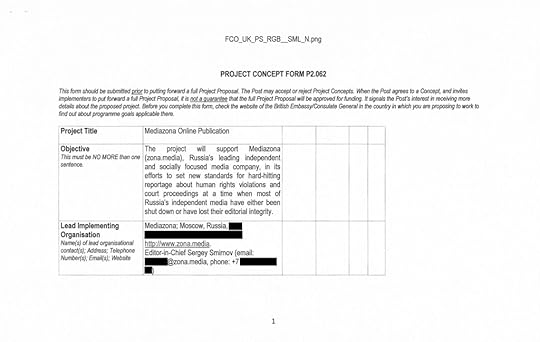
Boasting that “Mediazona contributes to the discussion of many legal and structural problems haunting Russian society and state, and also reports on foreign events (including in the UK) that have implications for Russians,” the proposal laid out the “key objectives set for Mediazona,” which included “[challenging] the official version of events by providing audiences with high-quality investigative journalism, compelling eye witness accounts and live feeds from the ground.” If approved, Mediazona would also “develop critical thinking amongst young Russians through the proactive use of social media networks and interactive content.”
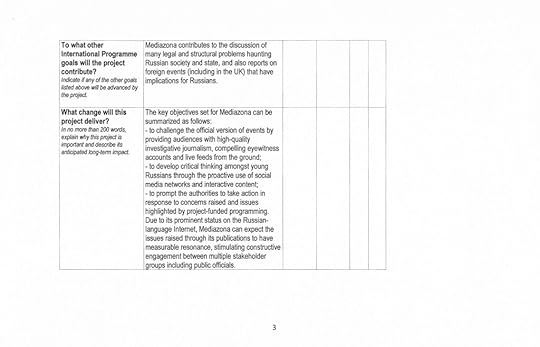
The applicants bragged that Mediazona’s “prominent status on the Russian-language internet” meant “issues raised through its publications” would “have measurable resonance, stimulating constructive engagement between multiple stakeholder groups including public officials.”
Mediazona would be expected to produce “around 120 news articles per week, at least 18 investigative reports per month and a series of online feeds delivered from crucial events across Russia.” The Foreign Office pledged, “this programming will serve to expose corruption and the abuse of power whilst bringing credible and authentic voices into the public domain.” In addition, the editorial team hoped to “forge new partnerships with key players in the Russian and international media landscape, thereby ensuring powerful multiplier effects.”
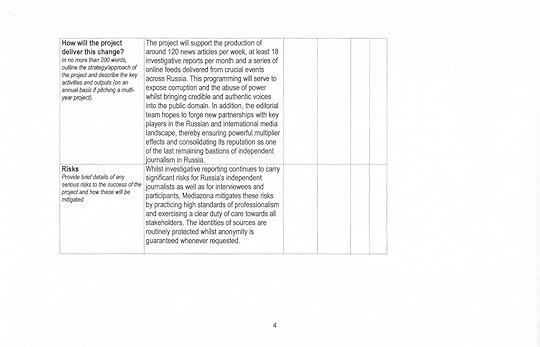
Elsewhere, the British Foreign Office received a petition for £150,000 over two years on behalf of Zona Prava, an NGO which was also founded by Pussy Riot. The organization would expose alleged human rights abuses in Russian prisons, via “public events” such as “hot lines, round tables, seminars, information events with the invitation of public figures and government representatives.” Meanwhile, in “close cooperation” with Mediazona, Zona Prava would produce “at least 800 materials in federal and regional media… at least 10 videos” and potentially one or two documentaries.
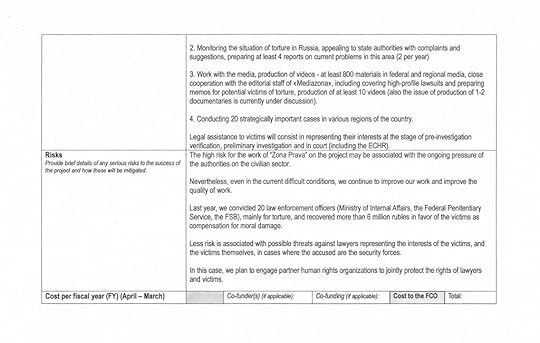 British intel circumvents ‘foreign agent’ law
British intel circumvents ‘foreign agent’ lawThe leaked documents make clear that the British were aware that their activities were illegal under Moscow’s Foreign Agent law. A funding application for Equal Rights Trust, a Global Britain Fund recipient charged with lawfare operations referred to cryptically as “targeted strategic litigation” explicitly describes a British government-funded effort to evade the new law. “As part of our current project” being financed by the UK Foreign Office, ERT wrote that it “has undertaken an extensive risk assessment of the Russian context, including commissioning an independent consultant to produce a report on the Foreign Agent Law.” As a result, “ERT is now well-versed” in various “procedures to mitigate the risks of transferring funds to Russia,” which “allowed for the ongoing successful implementation of activities despite the Foreign Agent law.”
These procedures included “diversifying means of transferring of funds, on-going assessment on methods of transfer, clear lines of communication with the recipient on when and how transfers are made, neutral codes and payment reference for bank records, and maximum amounts per transfer and numbers of transfers using the same method.”
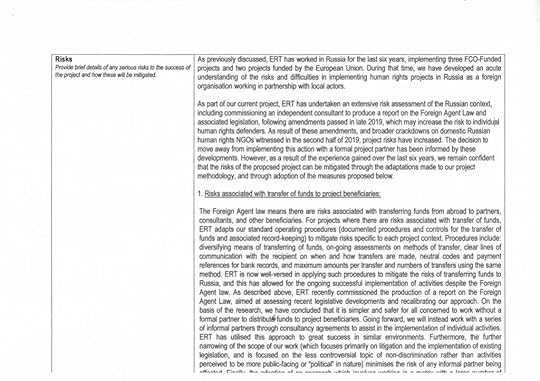
ERT concluded that “it is simpler and safer for all concerned to work without a formal partner to distribute funds to project beneficiaries,” and instead “work with a series of informal partners through consultancy agreements.” ERT was said to have “utilised this approach to great success in similar environments.”
It is unknown if the Global Britain projects involving Mediazona went ahead, and, if so, whether they used such “procedures” to launder the money. But the outlet’s long standing public alliance with the British state, via the project mapping Russian war casualties with the BBC’s Russian Service, highlights the outlet’s perceived utility as a conduit for anti-Kremlin agitprop.
Mediazona lashes out at damaging leaks with libelous allegationsIf financing did flow to Mediazona under “Global Britain,” it would not have been the first time London covertly supported the group’s activities. In February 2021, leaks reported by The Grayzone revealed how Mediazona had, alongside Meduza, received covert backing from British intelligence in the form of “audience segmentation and targeting support” some years prior. The assistance formed part of a wider clandestine effort to “weaken the Russian state’s influence.” While Mediazona’s top brass issued no official statement or response to the disclosures, a retort of sorts was promptly forthcoming.
Days after this outlet’s reporting appeared, Mediazona published a sensational exclusive, claiming Amnesty International’s decision to rescind Western-backed, imprisoned Russian opposition activist Alexei Navalny’s “prisoner of conscience” status resulted from a sinister Kremlin-orchestrated “campaign,” led by “individuals tied” to Russian state broadcaster RT. The supposed culprits were The Grayzone’s Aaron Maté, and a freelance writer and translator known as Katya Kazbek – neither of whom were tied to RT in any way.
Maté’s apparent sin was revealing how Amnesty had revoked Navalny’s status “given the fact that he advocated violence and discrimination and he has not retracted such statements.” For her part, Kazbek stood accused of posting a viral Twitter thread documenting Navalny’s lengthy history of racism, xenophobia, and association with and promotion of Neo-Nazi figures and groups, which he consistently refused to repudiate. She was subsequently doxxed by Bellingcat editor Natalia Antonova, who revealed sensitive private details, including her home address.
Amnesty International issued a statement explicitly denying “external pressure” from any source influenced its decision to remove Navalny from its list of “prisoners of conscience.” Nevertheless, Mediazona’s hatchet job was promptly translated into English by Meduza, where its charges were seized upon by mainstream Navalny endorsers and Western news outlets, including the BBC.
Meduza’s then-investigative editor, Alexey Kovalev, appeared to acknowledge the bogus story was revenge for articles exposing Britain’s clandestine support of both Mediazona and Kovalev’s employer, Meduza. In a 2021 tweet, Kovalev accused the author of this article of having “unleashed a careless conspiracy theory,” insisting that the leaked documents exposing those ties were “fake.” In closing, he sneered: “consider us square.”
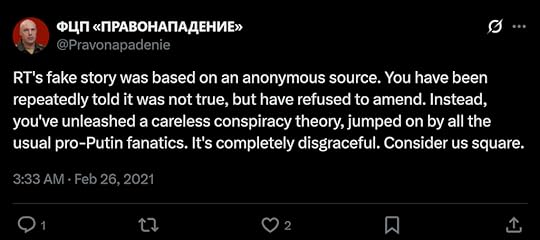
But the documents, and recent announcement by both Mediazona and Meduza, indicate that claims of secret Western sponsorship for the supposedly-independent outlets were anything but “fake.”
In a lengthy plea posted across their social media accounts entitled “Mediazona on the brink,” the group groaned that they were “running out of money” and urgently needed 5,000 monthly subscribers just “to stay afloat.” After Western sanctions forced Visa and Mastercard out of Russia, “funding from our readers” dried up, they wrote, explaining that the Ukraine proxy war’s outbreak “collapsed” the outlet’s business model “overnight.”
Mediazona claimed they’d already begun laying off staff as a result of budget cuts, warning if their subscriber target was not reached, layoffs “will have to continue.” Before the war, they claimed, the outlet was funded “almost [emphasis added] entirely” by reader donations. This glaring caveat strongly suggests they had been at least partially backed by government funding – a notion seemingly confirmed in a February 28 Euractiv interview with Nikita Dulnev, director of Mediazona’s Central Asia branch, who directly linked his outlet’s financial woes to the Trump administration’s shutdown of USAID.
Dulnev was described by Euractiv as one of many “media professionals in Eastern European countries” who fear Washington’s “abrupt funding cut” to local propaganda projects “could inflict lasting damage on the region’s media infrastructure.” In the article, Dulnev lamented, “for years, we had some support and didn’t diversify much. That’s why we had to pause our work.” Dulnev’s LinkedIn profile lists him as formerly employed by the “Khodorkovsky network.”
That international anti-Kremlin propaganda group was formed by London-residing exiled Russian oligarch Mikhail Khodorkovsky, who was released with members of Pussy Riot in December 2013 as a “magnanimous gesture” by Moscow towards the Russian opposition. Since then, Khodorkovsky has openly plotted Vladimir Putin’s downfall, though the full extent of this agitation is unknown.
Pussy Riot cofounders Maria Alyokhina and Nadezhda Tolokonnikova launched Mediazona almost immediately after their release alongside Khodorkovsky. A 2014 press release announcing their outlet’s founding explicitly linked Mediazona’s creation to the lack of “space for anything in [Russian] media that criticizes Putin’s policies.”
It was thus evident from day one that Mediazona was intended to serve as an extension of Pussy Riot’s political activism in Russia, which previously included Tolokonnikova’s participation in a public orgy at a Moscow museum in 2008, and other incendiary, criminal acts that would get perpetrators jailed almost anywhere in the world. The outlet quickly became a dependable megaphone for Western-sponsored opposition figure Alexei Navalny until his February 2024 death.
A February 2025 New York Times report confirmed Meduza had been in receipt of unacknowledged funds from USAID, a traditional US intelligence cutout, amounting to 15% of its annual income. This budgetary shortfall, they claimed, was sufficient to put the outlet’s entire future in jeopardy, and inflict more damage on its operations than previous alleged “cyberattacks, legal threats and even poisonings of its reporters.” The New York Times noted that financing for opposition media outlets from other foreign governments was “tiny in comparison with American funding” cut by the Trump administration.
Moreover, “traditional media supporters” such as the CIA-connected Ford Foundation and George Soros’ Open Society Foundations have “abandoned much of [their] media funding” outright. This abrupt lack of overseas bankrolling for anti-Kremlin propaganda operations was parenthetically acknowledged in Mediazona’s desperate March 31 plea for reader donations, which lamented that “grants from various foundations” are no longer forthcoming “in the current situation.” It appears Mediazona is also a victim of the US-led cessation of foreign funding for ‘independent’ media projects targeting enemy states.
As funding from Western governments dries up, Pussy Riot has launched a page on OnlyFans. The group’s “fetish/kink friendly” official profile on the website, widely used by sex workers, promises paying subscribers “daily exclusive photos and videos,” “one on one chatting,” “custom content and items,” and “exceptional service for all your personal requests.”
At the time of publication, promotional offers on three and six-month subscriptions are offered. It is unknown how many NATO member states, if any, have availed themselves of the opportunity.
June 28, 2025
War Profiteering?
Reported by The Lever Daily, 6/26/25
Lining their pockets off Trump’s war. In the months between Election Day and the president’s unauthorized strikes in Iran, nineteen members of Congress or their spouses reported purchasing defense stock in companies contracted with the government, reports Sludge. That includes Northrop Grumman, Lockheed Martin, and Raytheon, defense firms that all saw their stocks jump after the June 13 strikes on Iran.
One of the biggest purchases came from Senate Armed Services Committee member Sen. Markwayne Mullin (R-Okla.), who bought between $15,000 and $50,000 worth of stock in defense firm L3Harris in May. Meanwhile, the House Armed Services Committee’s Rep. Gil Cisneros (D-Calif.) purchased between $1,000 and $15,000 in Boeing, L3Harris, and Northrop Grumman stock just two weeks before the June 13 bombing.Kit Klarenberg: Palantir’s Value Soars With Dystopian Spy Tool that Will Centralize Data on Americans
By Kit Klarenberg, The Grayzone, 6/4/25
During an end-of-year investor call this February, Palantir CEO, co-founder and militant Zionist Alex Karp bragged that his company was making a financial killing by enabling mass murder.
“Palantir is here to disrupt and make the institutions we partner with the very best in the world and, when it’s necessary, to scare enemies,” he stated, adding: “And on occasion, kill them.”
On this front, Karp claimed Palantir was “crushing it,” and he professed to be “super-proud of the role we play, especially in places we can’t talk about.”
Karp went on to predict social “disruption” ahead that would be “very good for Palantir.”
“There’s a revolution. Some people are going to get their heads cut off,” he warned, suggesting that his firm was producing the most vital technology enabling elites to restore control during the coming unrest.
Denver-based Palantir [which specializes in software platforms for big-data analytics] is already playing a decisive role in the besieged Gaza Strip, where its products assist Israel’s application of a ferocious AI targeting system known as Lavender which directs its ongoing genocide.
In the face of public protest, Karp has acknowledged that he is directly involved in killing Palestinians in Gaza, but insisted the dead were “mostly terrorists.”
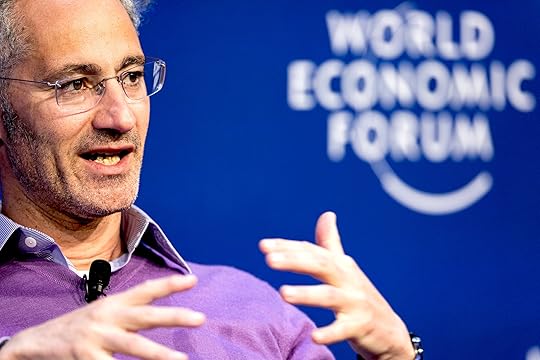
Karp at the World Economic Forum in May 2022 in Davos-Klosters, Switzerland. (World Economic Forum / Flickr, CC BY-NC-SA 2.0 )
At the start of January, the overtly pro-Israeli firm’s board of directors gathered in Tel Aviv for its first meeting of the new year. Since then, its financial fortunes have improved dramatically.
Throughout May, Palantir’s stock exploded, making it the S&P 500’s top-performing company. On June 2, Palantir’s share price hit an all-time high, a year-on-year jump of 512 percent, turbocharging the company’s market value to roughly $311 billion.
Driving this abrupt burst of investor exuberance was a series of lucrative deals signed with multiple U.S. government agencies since Donald Trump took office, and the expectation Palantir will ink massive contracts going forward.
Domestic Mass Surveillance & Pentagon Targeting
On May 30, The New York Times published a lengthy probe linking these deals to an executive order signed by U.S. President Donald Trump in March, calling for seamless, mass sharing of data across government agencies through a Palantir application called Foundry.
The report did not explain to readers how Palantir emerged as a small startup thanks to sponsorship from the C.I.A.’s venture capital wing, In-Q-Tel, which gifted Peter Thiel’s company $2 million in 2004. Instead, the paper leaned in to a partisan angle playing on Democratic fears that Trump could abuse a unified database to target political foes.

Thiel at the 2022 Converge Tech Summit in Scottsdale, Arizona. (Gage Skidmore, CC BY-SA 2.0)
Nonetheless, the Times provided valuable insight into Palantir’s penetration of a vast array of U.S. government agencies, by raking in more than $113 million in federal government spending since Trump took office, on top of “additional funds from existing contracts as well as new contracts with the Department of Homeland Security and the Pentagon.”
In late May, the company’s existing contract with the Department of Defense was beefed up by $795 million, bringing it to an eye-popping total award of $1.3 billion.
Palantir currently provides the Pentagon with AI targeting software known as Maven, which it uses in battlefields from Syria to Yemen to Ukraine and beyond. The contract will last until at least May 2029.
The Trump administration’s fondness for Palantir has placed its data analytics and storage tool Foundry in at least four federal agencies, including the DHS and Health and Human Services Department. Talks are also apparently ongoing with the Social Security Administration and Internal Revenue Service to adopt the resource.
This would facilitate merging all these agencies’ datasets.
Please Donate to the
Spring Fund Drive!
According to the Times, Palantir was selected to deliver on Trump’s order to enhance intradepartmental data sharing by Elon Musk’s Department of Government Efficiency.
At least three DOGE members previously worked at the company, while two others have worked at Thiel-funded firms. The outlet cited leaked screenshots indicating DHS officials exchanged emails with DOGE in February about merging citizen records, while quoting nameless Palantir employees worrying “about collecting so much sensitive information in one place,” particularly given the allegedly “sloppy” approach to security of “some DOGE employees.”
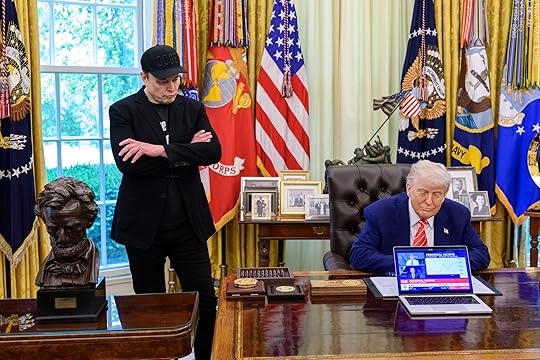
Musk with Trump on May 30 at a departure ceremony for the DOGE adviser in the Oval Office. (White House/Molly Riley)
While focusing heavily on the risks posed by Trump’s embrace of Palantir technology, the Times acknowledged in passing the company “has long worked” with different branches of the U.S. federal government, including the Centers for Disease Control and Prevention.
In February 2022, Palantir was enlisted by the Biden administration to manage Covid vaccine distribution.
Meanwhile, in April, Immigration and Customs Enforcement’s “removal operations team” gave Palantir $30 million “to build a platform to track migrant movements in real time.”
Karp, for his part, has infuriated Trump’s base by boasting during an interview in Davos, Switzerland, in 2023 that he “singlehandedly stopped the rise of the far-right in Europe” through an application called PG.
The following February, he claimed before an audience at the Future Investment Initiative Institute that by supposedly stopping “innumerable terror attacks” across Europe, Palantir prevented the resurgence of fascism.
“I love when I’m getting yelled at in cities in Europe,” Karp declared. “Keep yelling at me… the only reason why someone’s not goose-stepping between me and you is my product,” he laughed.
Privatized National Security State Backbone
For years, Palantir has been at the heart of U.S.-led efforts to neutralize Iran’s alleged nuclear program. It has created a predictive analytical tool dubbed Mosaic for the purpose, used by the International Atomic Energy Agency and U.S. officials to visualize ties among the people, places and material involved in the Islamic Republic’s nuclear activities.
Data harvested and pored over by the resource includes potentially tainted material supposedly stolen from Tehran by Mossad.
Such work mimics the services Palantir has provided for U.S. government agencies such as the C.I.A., DHS, F.B.I. and Pentagon. These entities routinely turn over untold quantities of data to the firm to exploit for a variety of applications.
For example, Palantir’s Gotham tool has been weaponized by the U.S. military to supposedly predict insurgent attacks. In Afghanistan, it combined maps, intelligence briefings and incident reports for mission planning, leading Bloomberg to dub Palantir the “secret weapon” of the so-called war on terror.
Meanwhile, documents leaked by National Security Agency whistleblower Edward Snowden indicate the U.S. signals intelligence giant and its British counterpart GCHQ have relied heavily on Palantir’s products.
A leaked 2011 presentation connected the company’s wares to multiple secret Five Eyes spying operations, and provided glowing personal testimonials from the agencies’ analysts.
One crowed: “[Palantir] is the best tool I have ever worked with. It’s intuitive, i.e. idiot-proof, and can do a lot you never even dreamt of doing.”
Local law enforcement agencies are also making use of Gotham. The total number of forces worldwide using the technology is unknown, but leaked Los Angeles Police Department training documents on Gotham, including an “Intermediate Course” and an “Advance Course,” shed significant light on the tool’s internal workings.
The sheer volume of data collected on citizens — whether they are law-abiding, are suspected of having committed a crime, or are simply connected to individuals accused of wrongdoing — is staggering.
This includes sex, race, names, contact details, addresses, prior warrants, mugshots, surveillance photos, personal relationships, past and current employers, tattoos, scars, piercings and other identifying features. Such a cutting-edge service doesn’t come cheap, and Gotham subscriptions run to millions of dollars annually.
The vast windfall reaped from multiple state entities since Palantir’s inception has made the firm’s founders very wealthy indeed —Karp’s personal worth alone is currently estimated at $12.2 billion — and allowed the company to go public in September 2020.
On top of the privacy concerns raised by a secretive company with access to so much private data, the practical efficacy of Palantir’s technology has also come under scrutiny since its Foundry application was implanted in Britain’s National Health Service (NHS) in December 2020.
That’s when Palantir was awarded a legally dubious no-bid contract to run the Service’s Covid-19 Data Store for two years despite warnings that the company could preside over “an ‘unprecedented’ transfer of citizens’ private health information” into its own database.

Palantir stand at the NHS Confederation conference 2022. (Rathfelder / Wikimedia Commons / CC BY-SA 4.0)
The following year, the NHS awarded Palantir a $447 million contract to build a “Federated Data Platform” combining the medical records of all British citizens.
Next, the British government paid millions to a consultancy firm called KPMG to market Palantir’s platform to local NHS Trusts, which oversee the administration of individual hospitals throughout the country. Since then, several senior medical officials have warned that Palantir’s technology was inferior to current systems, and could actually hinder NHS work.
Yet British Prime Minister Keir Starmer has continued his government’s cooperation with Palantir, even visiting the company’s offices in downtown Washington, D.C., immediately after meeting with Trump this February. Louis Mosley, the head of Palantir UK, cheered Starmer’s attitude after the visit: “You could see in his eyes that he gets it. The ambition is there — the will is there.”
Palantir’s Mosley happens to be the grandson of Sir Oswald Mosley, the World War II-era Nazi sympathizer who led the British Union of Fascists.
While Thiel’s personal affinity for Trump and close relationships with key members of the president’s cabinet may have eased Palantir’s entry into sensitive government areas, the company’s current trajectory has been years in the making.
Having penetrated the national security state of countries across the West, the firm and its messianic CEO are working to consolidate a trans-Atlantic network of control with unprecedented powers, lucrative profits, and a growing body count.
Kit Klarenberg is an investigative journalist exploring the role of intelligence services in shaping politics and perceptions.
This article is from The Grayzone.
June 27, 2025
Dr. Piers Robinson: The IAEA and OPCW: Watchdogs for Peace or Propagandists for War?
By Piers Robinson, Substack, 6/26/25
Dr Piers Robinson is a co-director of the Organisation for Propaganda Studies, Research Director for the International Center for 9/11 Justice, co-editor of the Journal for 9/11 Studies & co-editor of Propaganda in Focus.
On the 12 of June, the world’s nuclear watchdog, the International Atomic Energy Agency (IAEA), issued a damning statement that accused Iran of being in breach of its commitments to the nuclear Non-Proliferation Treaty (NPT). Its resolution, adopted during the 1769th session of its board of governors, declared:
Iran has failed to provide the co-operation required under its Safeguards Agreement, impeding Agency verification activities, sanitizing locations, and repeatedly failing to provide the Agency with technically credible explanations for the presence of uranium particles of anthropogenic origin at several undeclared locations in Iran or information on the current location(s) of nuclear material and/or of contaminated equipment, instead stating, inconsistent with the Agency’s findings, that it has declared all nuclear material and activities required under its Safeguards Agreement.
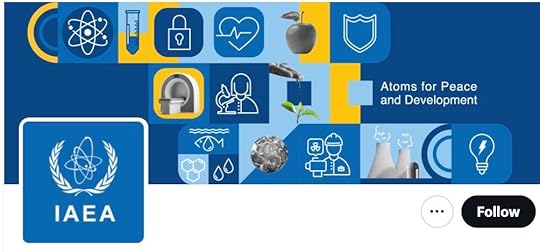
Within hours Israel initiated attacks on multiple Iranian nuclear sites justified by the claim that Iran was developing a nuclear bomb. What turned out to be a 12-day war on Iran had begun and, by the 22nd of June, the US had bombed Iranian nuclear facilities, and Iran had launched a strike on a US military base in Qatar.
As soon as the IAEA had issued its statement on the 12 of June, Iran accused it of co-ordinating with Israel and sharing data provides by the IAEA’s Mosaic artificial-intelligence platform. As Sarah Bils details, the Mosaic platform was developed by Palantir who also ‘power IDF targeting in Gaza and Ukraine’s battlefield’. Palantir was also co-founded by Peter Thiel who is closely allied to US president Trump. By June 18th the Director General of the IAEA, Rafael Grossi, was having to admit on CNN that there was no ‘proof of a systematic weapons program’ (Bils, 2025).
It is difficult to avoid the conclusion that the IAEA is, to all intents and purposes, entangled in propaganda efforts aimed at legitimating military action against Iran in pursuit of what are long-standing policies aimed at obtaining ‘regime-change’ in Iran. If this does indeed turn out to be the case, it fits a pattern in which manipulated or spun intelligence and co-opted international institutions are used as trigger mechanisms for war. At this juncture, a brief reminder of recent history helps clarify and contextualise what we are seeing today with the IAEA and Iran.
The Case of Syria and Alleged Chemical Weapons Attacks
Between 2011 and 2024, during the Western-backed regime change war against Syria, repeated allegations were made that the Syrian government was using chemical weapons against its civilian population. None of these allegations stand up to scrutiny, yet they have been a central component of a propaganda campaign designed to demonise the Assad government as well as to both maintain and increase Western military actions. At critical junctures Western intelligence-linked actors have been involved in fabrications related to alleged chemical weapons incidents (see here and here).
Throughout this 14-year period the world’s chemical watchdog, the United Nations-linked Organisation for the Prohibition of Chemical Weapons (OPCW), played a central role in maintaining the false narrative. This was achieved through the creation of an ad-hoc mechanism, the Fact Finding Mission (FFM), that actually operates outside the framework of the Chemical Weapons Convention. These FFMs became integrated with covert operations carried out by Western-linked actors, some of whom were involved in the staging of chemical weapons incidents.
In what was a demonstrably corrupt scientific process, matters came to a head during the OPCW FFM sent to investigate the alleged chemical weapons attack in Douma, 2018. Here investigators involved with the FFM ended up blowing the whistle on how the investigation had been corrupted. Evidence leaked from the OPCW demonstrated that the investigation had been manipulated so as to reach a ‘pre-ordained conclusion’ blaming the Syrian government. Rather than investigating the corruption within his organisation, the OPCW’s Director General, Fernando Arias, chose to smear and then silence his own inspectors.
The Case of Iraq’s alleged WMD stockpiles
During the run-up to the US-led invasion of Iraq in 2003, the US and British governments repeatedly accused the Iraqi government of producing weapons of mass destruction (WMD). These claims were based on intelligence and, at the time, the US faced varying degrees of resistance from the international organisations tasked with assessing Iraqi capabilities. Dr Hans Blix – head of the United Nations Monitoring, Verification and Inspection – resisted US pressure to confirm their intelligence. José Bustani, the first Director General of the OPCW, was forced from his post by John Bolton (Under Secretary of State for Arms Control and International Security Affairs) because he would not play ball with the US propaganda drive. The US invaded Iraq in March 2003, triggering years of violence and destruction within the country.
As is now well-established, following years of inquiries and leaks, that the intelligence used to justify the invasion of Iraq had been manipulated and, in some cases, likely fabricated to present a seriously misleading impression of Iraqi WMD capabilities. The notorious September Dossier published by the UK government even claimed Saddam could fire missiles against British targets within 45 minutes of an order from Saddam Hussein. None of this was true and nothing was ever found in Iraq.
Moreover, it is now clear that the WMD narrative merely served the purpose of enabling a regime-change war planned since the 1990s which, in turn, was part of a series of conflicts planned and enabled by the 9/11 manufactured war trigger.
History Repeats Itself
There is a clear pattern here in which false claims about the production and use of prohibited weapons – chemical, biological, nuclear – are made by belligerent states seeking to instigate and justify war. In doing so, international organisations, which are supposed to maintain the peace by objectively and fairly monitoring any alleged activities, are either sidelined or co-opted by belligerent nations. Institutions established for peace have become weapons of war.
Moscow Times: Russia’s Richest Have Gained $22.5Bln Since Start of 2025
Moscow Times, 6/2/25
Moscow Times is a western owned media outlet.
Russian billionaires have collectively gained $22.5 billion since the start of the year, according to the Bloomberg Billionaires Index.
The ranking of the world’s top 500 richest people includes 22 Russians whose combined wealth stood at $317.7 billion as of Monday.
Metals tycoon Vladimir Potanin remained Russia’s richest person, with his net worth rising by $3.82 billion since January to $31.7 billion.
He was followed by Lukoil founder Vagit Alekperov, whose net worth rose by $561 million to $25.9 billion, and mining magnate Vladimir Lisin, who retained third place with $24.2 billion despite losing $1.62 billion in five months.
The only Russian billionaire to lose more than Lisin was fertilizer tycoon and AS Monaco football club owner Dmitry Rybolovlev, whose wealth dropped by $1.77 billion to $9.21 billion, placing him in the bottom five.opinionRussia’s Potato Dilemma Risks Causing a Health CrisisRead more
Russia’s wealthiest woman Tatiana Kim lost $597 million and ranked 21st with a net worth of $6.77 billion, just ahead of metals tycoon Iskander Makhmudov, who rounded out the list at $6.74 billion.
Makhmudov, whose fortune rose by $3.61 billion, was among the top gainers after Potanin and Alisher Usmanov, whose wealth grew by $3.7 billion to $16.9 billion, making him the seventh-richest Russian.
Senator Suleiman Kerimov added $3 billion to reach $10 billion in 15th place. Industrialist Viktor Vekselberg earned $2.25 billion to reach $9.54 billion, while tech entrepreneur Pavel Durov earned $2.03 billion and ranked 10th with a net worth of $13 billion.
After Potanin, Alekperov and Lisin, the top five wealthiest Russians also included Novatek gas major chairman Leonid Mikhelson, whose fortune rose by $860 million to $23.2 billion, and industrialist Alexei Mordashov, who lost $598 million and was valued at $22.6 billion.
June 26, 2025
Popular Mechanics: In a First, America Dropped 30,000-Pound Bunker-Busters—But Iran’s Concrete May Be Unbreakable, Scientists Say
By David Hambling, Popular Mechanics/Yahoo News, 6/24/25
On Saturday, June 21, 2025, following a spate of unprecedented aerial attacks that Israel carried out against Iran just days before, the United States joined the war and used bunker-busting bombs to strike three key Iranian nuclear sites and their underground bunkers: the Fordow fuel-enrichment plant, the Natanz nuclear facility, and the Isfahan nuclear technology center.
Operation Midnight Hammer, the Pentagon’s codename for the strikes on Iran, marks the first-ever use of the Massive Ordnance Penetrator (MOP), a colossal 30,000-pound bomb that only the B-2 stealth bomber can carry. As such, America has been regarded as the only country capable of taking out Iran’s underground nuclear facilities, and therefore its nuclear program—but if it actually accomplished that feat is yet to be seen.
While President Trump declared that the operation “completely and totally obliterated” the sites, Iranian officials downplayed the attacks. As of publication time, it’s unclear the level of damage inflicted based on satellite imagery alone, but a CNN report published on Tuesday afternoon claims that the strikes on Iran did not destroy the country’s nuclear program and has instead only set it back by a matter of months, according to early U.S. intelligence.
If history serves as any indication, there is a chance Iran’s underground nuclear facilities could be partially or wholly intact. That’s because up until now, in the quiet arms race between concrete and bombs, the concrete has been winning.
In the late 2000s, for instance, rumors circulated about a bunker in Iran struck by a bunker-buster bomb. The bomb had failed to penetrate—and remained embedded in—the surface of the bunker, presumably until the occupants called in a bomb-disposal team. Rather than smashing through the concrete, the bomb had been unexpectedly stopped dead. The reason was not hard to guess: Iran was a leader in the new technology of Ultra High Performance Concrete, or UHPC, and its latest concrete advancements were evidently too much for standard bunker busters.
Stephanie Barnett, Ph.D, of the University of Portsmouth in the U.K. is involved in developing stronger concrete to protect civilian buildings from terrorist attacks, and has heard about Iran and its ultra-tough concrete. While civilian audiences have been enthusiastic about the advancements in concrete, she occasionally hears less positive responses from military personnel attending her presentations.
“One officer told me, ‘If you make this stronger blast- and impact-resistant material, we need to think about how to get through it,’” Barnett says.
The U.S. Air Force introduced its first modern bunker buster in 1985. General-purpose bombs have a thin steel casing filled with explosives, while bunker busters have a narrower profile, with a thicker casing and less explosives. This design concentrates all the weight on a smaller area, making it an ice pick rather than a hammer, so the bomb can smash through concrete or burrow through earth to strike deeply-buried targets.
While the same general-purpose bombs from the 1990s are being used today, bunker busters had to go through several generations of upgrades. In the early 2000s, the Air Force even developed a special type of steel for the purpose, known as Eglin Steel, in association with steel specialist Ellwood National Forge Company.
Eglin Steel is a low-carbon, low-nickel steel with traces of tungsten, chromium, manganese, silicon, and other elements, each contributing a desirable property to the whole. Eglin Steel is the gold standard for bunker-busting munitions, although in recent years it has been supplemented by new USAF-96 steel, which boasts similar performance but is easier to produce and work with.
Materials scientists distinguish between the two qualities of toughness and hardness, and it is the balance between them that drives arms races between weapons and armor.
Poll: Record number of Russians want the war to end, Putin Remains Popular
Intellinews, 6/3/25
A record number of Russian citizens now want the war to end, according to a new poll by the independent pollster, the Levada Center, the Moscow Times reported on June 3.
The poll, conducted between May 22 and 28 across 50 Russian regions, found that 64% of respondents favoured peace negotiations—up six percentage points from March. Meanwhile, support for continuing the war fell to 28%, down from 34% in the same period.
Support for ending the conflict has grown steadily over the past two years. In May 2023, 48% of Russians said the war should continue. By May 2024, that figure had dropped to 43%.
The latest data was published shortly after the second round of direct peace talks between Ukraine and Russia took place in Istanbul on May 16, raising hopes that a negotiated end to the hostilities could appear soon.
While no ceasefire agreement was reached, the negotiations resulted in a new 1,000 for a 1,000 prisoner exchange and the repatriation of 6,000 bodies of fallen Ukrainian soldiers.
Levada’s survey also highlights demographic and political divides. Support for peace is highest among women (73%), young people under 24 (77%), and residents of smaller towns and villages (67%). It is also prominent among respondents who believe Russia is moving in the wrong direction (76%) and those who disapprove of President Vladimir Putin’s performance (77%).
Conversely, backing for continued military action is stronger among men (39%), those aged 55 and older (35%), and Moscow residents (40%). Among those who say the country is headed in the right direction, 32% support the war, as do 30% of those who approve of Putin’s leadership.
A majority—73%—of respondents said Russia and Ukraine should address the “root causes” of the conflict before agreeing to a ceasefire – a phrase often repeated by Putin as the reason to delay ceasefire talks. Just 18% believed a truce should come first.
Only 3% of those surveyed viewed Russia as an obstacle to peace, while 36% blamed Ukraine and 36% pointed to European countries. 14% said the United States bore responsibility for blocking peace efforts.
Putin remains popular
While support for bringing the war to end may be rising, as the conflict moves into its fourth year, that has not affected Putin’s personal popularity.
The level of trust in Putin among the Russian public remains steady and is currently 81%, while 82% of respondents approve of his job performance, a survey conducted by the Public Opinion Foundation (FOM) showed between May 23-25 of 1,500 respondents, TASS reported on May 30.
A total of 57% of those polled said they approved of the Russian government’s handling of the country (a 1% increase), while 61% approved of Prime Minister Mikhail Mishustin’s performance (a 3% increase).
Support for the government also remains unusually strong with some fluctuations. The ruling United Russia party fell by 2% to 46%. Support for the Communist Party of the Russian Federation (KPRF) rose by 1% to 8%, while support for the [right wing nationalist] Liberal Democratic Party of Russia remained at 10%. The A Just Russia-For Truth party’s support held steady at 3%, while support for the New People party increased by 1% to 2%.
June 25, 2025
Mark Curtis: Blair & Major Reassured Russia About NATO
By Mark Curtis, Declassified UK, 5/19/25
Declassified British files shed further light on the controversial question as to what assurances were made to Russia by U.K. officials about the expansion of NATO into eastern Europe.
The documents show then Prime Minister John Major telling Russian Foreign Minister Yevgeny Primakov in February 1997 that “if he were Russian he too would be concerned by the possibility that NATO might move up to Russia’s borders.”
But Major added that “NATO has no intention of doing this” and was “not seeking to box in Russia.”
Briefing notes drawn up by No. 10 Downing Street [the prime minister’s office] for Major’s phone call with Primakov stated: “We are not seeking to encircle Russia with NATO members.”
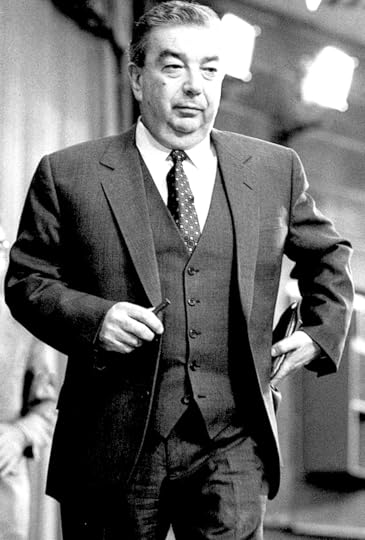
Primakov in 1991. (RIA Novosti archive /Prihodko / Wikimedia Commons /CC-BY-SA 3.0, CC BY-SA 3.0)
The following month, Major wrote to Russian President Boris Yeltsin saying: “I am well aware of Russian concern that NATO enlargement may mean that NATO forces will effectively move nearer your own borders. I well understand the fears that may be aroused in Russia.”
However, he added:
“But let me assure you that such fears are quite without foundation.”
The reason was that
“NATO has no intention of stationing large conventional forces or nuclear weapons on the territory of new members.”
Major also reassured Yeltsin that NATO would only deploy “a modest amount of NATO infrastructure… such as storage facilities and command and control arrangements.”
The declassified files released to the National Archives covering 1996-97 are full of references by U.K. officials to Russian “concern,” “negative attitudes,” “fears,” “hostility” and “resentment” about NATO enlargement.
At the time, NATO’s expansion was being considered for only a small number of central European countries, not former states in the old Soviet Union, such as Ukraine — which was an even more sensitive issue to Moscow.
An August 1996 paper drawn up by Downing Street clearly noted Russia’s policy of “not allowing Ukraine or the Baltic States to join NATO.”
‘Enlarge NATO anyway’
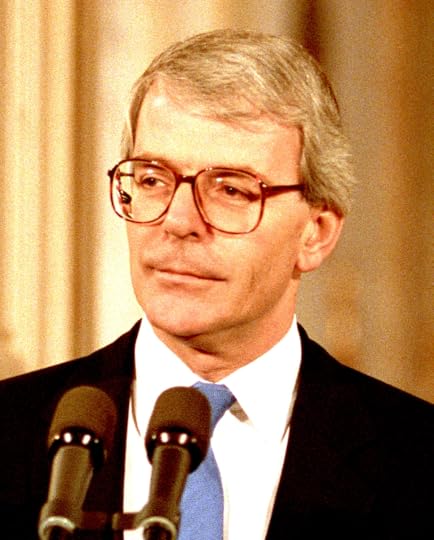
Major in February 1993, during a visit to the Clinton White House. (White House Photograph Office/Wikimedia Commons /Public Domain)
U.K. officials believed the Russians reluctantly “tacitly accept that enlargement will go ahead” — subject to their opposition to nuclear and conventional force deployments — “but cannot say so publicly.”
In December 1996, Russian Prime Minister Viktor Chernomyrdin told Major in private: “Russia could not stop NATO enlarging, but this would create a fragile situation which could explode.”
Major assured him: “We did not wish to do anything to unsettle Russia.”
[See: Tangled Tale of NATO Expansion at Heart of Ukraine Crisis]
The files show that Britain was intent on expanding NATO to include “some” central/eastern European countries.
A policy paper drawn up in September 1996 said U.K. objectives were “to enlarge NATO to the East” and “secure Russian acquiescence in enlargement … But if Russian acquiescence is not possible, for NATO to enlarge anyway.”
The paper was drawn up by Foreign Office official Matthew Rycroft, who in 2003 would be former Prime Minister Tony Blair’s private secretary during the war in Iraq.
‘Full Account of Russia’s Place’
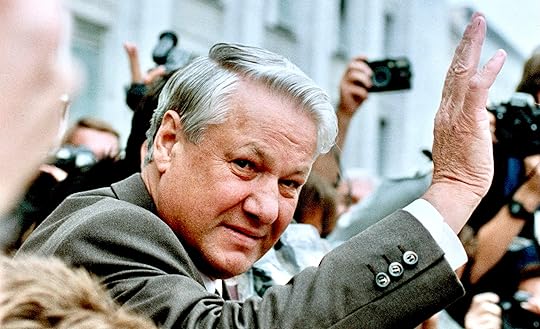
Yeltsin waving at reporters in Moscow in August 1991. (Kremlin.ru /Wikimedia Commons /CC BY 4.0)
In the month Blair succeeded Major as prime minister, May 1997, Britain’s ambassador to Russia, Andrew Wood, cabled London saying: “NATO enlargement [is] a painful issue with domestic implications.”
He added: “The Russians are virtually at one in regarding the coming enlargement of NATO as a humiliating defeat, and in supposing that the West either consciously or unconsciously intends it to be seen as such.”
Please Donate to the
Spring Fund Drive!
However, Yeltsin also conveyed, in a phone call with Blair the same month, that he understood that “there was no turning back” on enlargement. But he again insisted that nuclear weapons should not be sited in new NATO members and that there should be “no permanent deployment of conventional forces.”
[See: Boris Yeltsin Privately Supported NATO Expansion Despite Public Stance]
A British prime minister again offered assurances to Moscow. A briefing for Blair’s meeting with Yeltsin in May 1997 stated on the subject of NATO enlargement: “We will not allow Russia’s legitimate security interests to be damaged in this process.”
It added that “an enlarged NATO will mean more security in Central Europe. This is in Russian as well as NATO interests.”
Blair told Yeltsin “he was aware of the view Russia took on NATO enlargement” and that “arrangements for the future had to take full account of Russia’s place and weight in Europe.”
Later that year, in October, Yeltsin told Blair again in a phone call that “he continued to oppose enlargement of NATO, which was a mistake. Europe should not be divided.”
At the time discussions were taking place about a comprehensive security system for Europe, replacing the old East-West divide and giving Russia a place in that system. It was clear, however, that NATO, led by the U.S., privileged expanding the organisation over bringing in Russia into a new European security architecture.
At NATO’s summit in Madrid in July 1997, the Czech Republic, Hungary and Poland were invited to begin accession talks, and they joined NATO in 1999. A further wave of accession occurred in 2004 when Bulgaria, Estonia, Latvia, Lithuania, Romania, Slovakia and Slovenia all joined NATO.
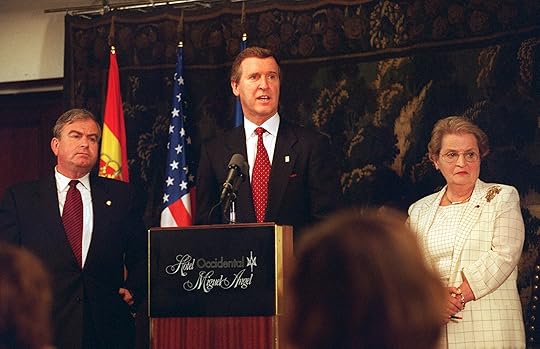
U.S. Secretary of Defense William Cohen giving a press statement on July 8, 1997, in Madrid, about NATO’s decision to invite Poland, Hungary and the Czech Republic to begin negotiations to join NATO. National Security Advisor Samuel Burger on left, Secretary of State Madeleine Albright on right. (DoD/ R. D. Ward/Wikimedia Commons / Public Domain)
By 2017, NATO had established a “forward presence” policy in eastern Europe, deploying battalion-size battlegroups in Estonia, Latvia, Lithuania and Poland. NATO claims this was needed in response to Russia’s “aggressive actions against its neighbours,” notably its [supposed] 2014 invasion of Crimea.
Opposing Ukraine
British files from 2001 show that Defence Minister Igor Sergeyev warned NATO that any further enlargement would be “a major political error” requiring Moscow to take “appropriate steps.”
By 2002, when Britain was supporting a new wave of central/eastern European states becoming members of NATO, Blair’s government was explicitly opposed to Ukraine joining the organisation, the files show.
“We do not support Ukraine’s request to join MAP,” the Foreign Office noted in 2002, referring to NATO’s Membership Action Plan, which provided advice to countries aspiring to join NATO.
Though Kyiv was pushing strongly for an enhanced relationship with NATO, Ukraine’s bid was “premature” in the British view since the country was “far from meeting criteria expected of aspirants.”
The U.K.’s chief diplomat at NATO, Emyr Jones Parry, noted that Ukraine was “on notice that deepening relations with NATO will require more democratic and other reforms.”
But also critical for British officials was the impact on relations with Russia. U.K. strategy was “to steer Ukraine away from any suggestion of membership except in the very long term” given the “serious impact on NATO relations with Russia.”
“Ukraine membership of MAP would greatly complicate our handling of the new Nato-Russia relationship and would raise serious Russian concerns about Nato’s strategy,” reads a 2002 briefing note for the prime minister.
Barrier to Russia
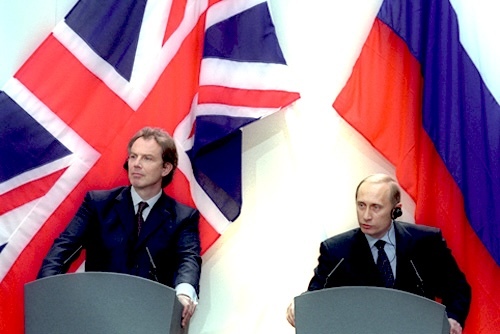
U.K. Prime Minister Tony Blair and Russian President Vladimir Putin, 2000. (Kremlin.ru / Wikimedia Commons / CC BY 4.0)
At the time, the Labour government was seeking a “transformed relationship between Russia and the Alliance,” a process which was described as “truly historic.” Indeed Blair was courting Vladimir Putin after MI6 had helped him into power in 2000.
British officials were impressed with Moscow’s declared support for the U.S. following the 9/11 attacks in September 2001 and sought a new strategic relationship.
Though British officials opposed Ukraine joining NATO at this time, some spotted the country’s geopolitical importance.
Roger Liddle, Blair’s special adviser, wrote that Ukraine played a key role as a supply route for Russian gas. But also Ukraine could act “as a formidable barrier to any resurgence of Russian Imperialism to the West.”
At its Bucharest summit in 2008, NATO pledged that both Ukraine and Georgia would eventually become members.
Mark Curtis is the co-director of Declassified U.K., and the author of five books and many articles on U.K. foreign policy.
This article is from Declassified U.K..



